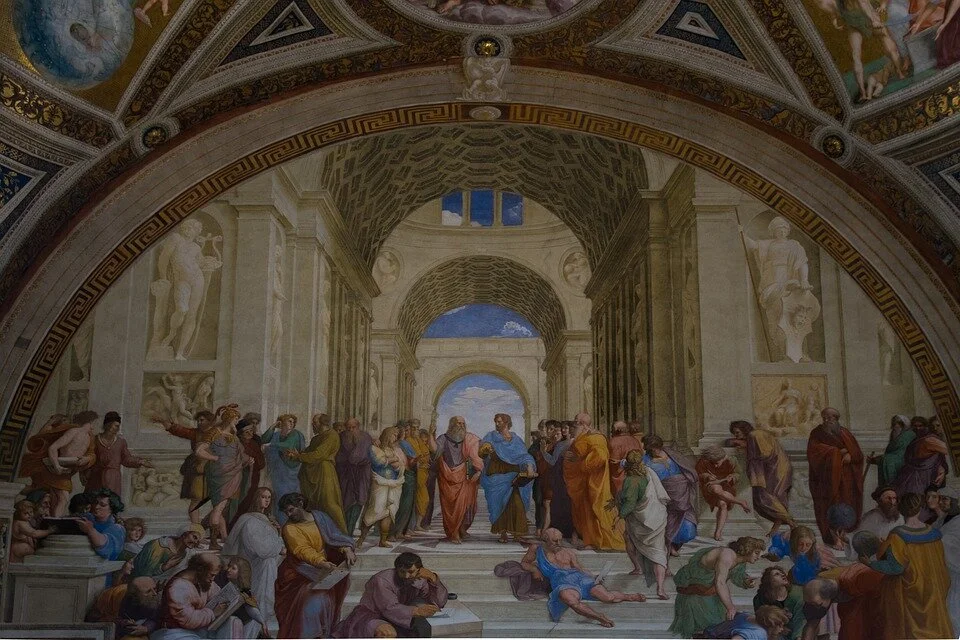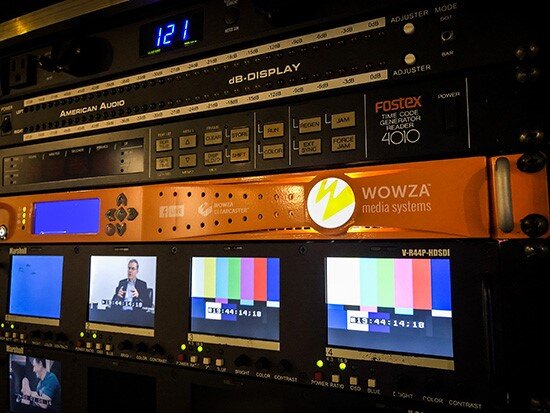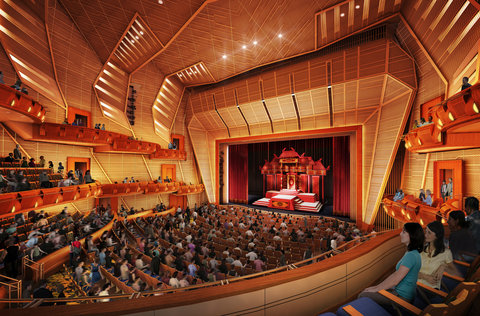Theatre live broadcasting has existed across various media for nearly a century. In its early days, it was delivered through radio and television. In the 21st century, advancements in technology enabled broadcasts on large cinema screens. During and after the COVID-19 pandemic, however, lockdowns and shifts in audience behavior appeared to redirect attention back to small screens. This research explores the meaning of “liveness” and whether live theatre broadcasts, sometimes costing up to $3 million, are worth the investment.
AI And Theatre: Playwriting, Stage Design, and Ticketing
Artificial Intelligence is being experimented with in the world of theater, from playwriting in traditional theatre, musicals, and improv. It is also being used for scene design and as a creative collaborator and director. Can AI successfully produce on these fronts? What does this mean for the future of the industry?
Theatre Futures: Data and Strategy
The 2022 Theatre Communications Group conference offered virtual, hybrid, and in-person experiences. Hosted in Pittsburgh, the conference adeptly revealed the opportunities and challenges facing the field as theatre artists and institutions navigate their futures. The following summary offers two core takeaways from the conference, focusing on a theatre administration future of human-centered strategies allowing adaptive innovation within a constantly changing ecosystem.
Aristotle & Gaming Case Studies (Tragedy is Fun: Aristotle Revisited)
As noted in How Video Games Can Serve as an Engagement Experience, video games, particularly RPGs, are widely popular and engaging with exceptional character and plot structure. The Elder Scrolls V: Skyrim and The Witcher 3: Wild Hunt exemplify Aristotle’s model of dramatic tragedy in a modern form. These case studies prove that video games are fun, tragedy is fun, and by marrying the two, arts organizations can experiment with exciting new forms of audience engagement!
Case Studies of Livestreaming in Theatre: Part 2
When considering the medium of livestreaming for organizational programming, one must be aware of its many advantages and challenges. This second portion looks at two case studies. The first case study, The Geffen, set the precedent for non-Broadway theaters working with BroadwayHD. The second case study, The Orlando Shakespeare Theater, illustrates how a large regional theater can impact hundreds of classrooms with one performance, on a budget that is more feasible for regional theater companies.
Livestreaming for Regional Theatre: History and Perspectives: Part 1
This is a two-part series exploring how the benefits of incorporating livestreaming technology into theatres. Part 1 of the report documents a history of livestreaming theatre (involving a timeline and the lifespan of the industry’s biggest players) and a brief analysis of what it means to perform “Live!” and its programming potential.
#TBT: The Web-Based Arts Experience
When discussing the future of the arts, many professionals and studies have stated that the manner in which audiences consume arts and culture is rapidly changing--and has already changed. The Internet has been the most notable new space for consuming culture, providing both opportunities and challenges through widespread and instant information sharing. Over the past several years, AMT Lab has documented the various web-based arts experiences that are becoming readily available--usually including lessons and best practices that managers can take away for their own practice. This week’s TBT rounds them up into a user-friendly toolbox of online arts experiences of various artistic mediums.
National Ticketing Survey Participation Period Extended!
Already your responses are providing valuable insight. AMT Lab has extended the 2015 National Ticketing Software Satisfaction Survey period through March 7, 2015. Collecting information on the attitudes and behaviors of arts organizations currently using ticketing software, the 2015 National Ticketing Survey will help illustrate the met and unmet ticketing needs of art organizations, and capture how ticketing software uses and needs vary by an organization's discipline, budget, staff size, and geographic location. Clear here for the full announcement.
What do you think about your ticketing software?
We are conducting the 3rd National Ticketing Software Survey during the month of February. If you are interested in sharing your experience and your opinions about your software, please let us know. All those participating in the survey will receive a full copy of the report which will provide a national view as well as cluster analyses by discipline, budget size, and geographic region. The data will be useful for both organizations and vendors. Organizations will gain a better understanding of their own practices as compared to their peers and, more importantly, be able to use the findings as evidence for future technology funding campaigns. Vendors will have explicit evidence as to the needs and wants for future software design.
To Tweet Seat or not to Tweet Seat: A Perspective
To tweet seat or not to tweet seat; that’s the question on everyone’s mind. After a rather engaging conversation at the Theatre Communications Group Annual conference in Dallas, I went home thinking about the pros and cons of new technology and how it can be used to engage today’s audience. If our audiences are evolving, why are we still connecting with them in the same manner as the previous generation of administrators?
Technology and Immersive Audience Engagement: Part I of II
Last week's Theatre Communications Group conference presented a changing perspective on audience engagement that uses technology. Tweet Seats are definitely on the outs. This 2 post series, however, focuses on the more immersive experience with two organization's successfully engaging their audiences. Their audiences must engage in some if not multiple forms of technology to partake in the theatrical story itself. The two organizations are Dog and Pony DC based in Washington DC and Rude Mechanicals based in Austin. Both use technology before, during and after the show. Dog and Pony DC's company member, Colin K. Bills, presented as part of a panel led by David J. Loehr of twitter handle @2amt (and 2amtheatre.com).
The Peril of Tweet Seats
Stop me if you’ve heard this one – your local symphony has an upcoming production, and in order to draw in a younger crowd offer Tweet Seat tickets. The young kids come, spend the performance merrily on their phones, and head home. The next week, the symphony is slapped with a cease and desist – wait, what? I’ll start at the beginning. Tweet Seats are a new engagement tactic for performing arts organizations, utilizing social media and modern technology. The idea is that some seats in your house are reserved for people who wish to utilize their phone during the show. These patrons use Twitter or other social media to discuss and engage the performance at hand. Usually these seats are less expensive and in the back of the house, so as to not disturb the other patrons.
Some people (read: me) love the idea – others hate it, and the most thoughtful question its ability to truly increase engagement. Regardless, Tweet Seats are here to stay. Huffpo has written on them, Wolf Trap has used them, and now some troll claims to have successfully patented them.
The story dropped back in March, but it’s still very relevant to anyone considering using Tweet Seats in an upcoming production. Inselberg Interactive is the company holding the patent, whose language refers specifically to sporting events, but they have already demanded license fees from a nonprofit theatre in Connecticut. Ars Technica has the full story and analysis, but it basically boils down to this:
The company holding the patent doesn’t claim to have invented the smart phone technology or the social media apps Tweet Seats utilize. They claim to have invented the process of, I don’t know, tweeting at live events. Still with me? Good.
Patents, according to the US Patent and Trademark Office protect inventions and improvements to existing inventions. They also, according to my one semester of law class, must be novel and non-obvious. This patent was issued in 2005: Twitter didn’t exist and baby Facebook was just starting to let high school students in. At that time, this probably was a novel idea – but it was just an idea. Patents don’t usually apply well to ideas, they need a more tangible form.
Patents can be challenged and litigated against, but that costs time and legal fees. Given that this troll has turned their focus to the non-profit world, it’s unclear if those are available resources.
And when you consider that patents have a minimum shelf life of 14 years, I don’t think it’ll be going away unless someone smacks them down in court.
For Those of You Who Can't Stand It Anymore: A Homemade Cell Phone Jammer
 The invention of the cell phone and more specifically the advent of text messaging and smart phone technology have been disruptive to the traditional theatre environment. For some, even now, the thought of being distracted by the light they give off, the sound of tapping keys, and the sound a phone on vibrate is enough to cause an altercation.
Please note that actually building a cell phone jammer is against the law in the US and many other countries. Having said that, Wired recently published instructions for how to create a device that broadcasts disruptive signals on the same frequency that cell phones use to communicate with towers. These devices would be enough to disrupt a cell phone signal in a mid sized theater, thereby making the cell phone functionally inoperative.
The invention of the cell phone and more specifically the advent of text messaging and smart phone technology have been disruptive to the traditional theatre environment. For some, even now, the thought of being distracted by the light they give off, the sound of tapping keys, and the sound a phone on vibrate is enough to cause an altercation.
Please note that actually building a cell phone jammer is against the law in the US and many other countries. Having said that, Wired recently published instructions for how to create a device that broadcasts disruptive signals on the same frequency that cell phones use to communicate with towers. These devices would be enough to disrupt a cell phone signal in a mid sized theater, thereby making the cell phone functionally inoperative.
The idea around cell phone jammers isn't new, but it does call to question whether or not the performing arts community has outgrown this idea of creating a quiet, even sacred, space for performance. Innumerable performing arts institutions now give permission, even blessings, to smart phone users in some performances or in certain parts of the house. Even more, however, still ask patrons to turn off all electronic devices before a show begins.
So, is it time for a cell phone jammer or is it time to bring smart phone seats to your house?
The Space: A Summer of English Arts on a New Experimental Platform
This Olympiad summer, the arts in the UK will be consolidated onto a single online platform called The Space. What’s more? The content on The Space is being provided for free! There’s room, or more fittingly, seats for all, at venues such as the World Shakespeare Festival or Yayoi Kusama’s Obliteration Room at the Tate.
“The Space is a new way to access and experience all of the arts – for free.Available on computer, tablet, smartphone and connected TV, The Space invites you to take part in the biggest summer of arts the UK has ever seen, whenever you want it and wherever you happen to be. ”
 The Arts Council England in partnership with the BBC created The Space as a way for people from all over the world to experience the country’s rich and dynamic arts scene. In effect, a summer of English arts to all! (Albeit without the English summer and its cool Constable Skies). So The Space is certainly something to look forward too because it will feature some of the UK’s best theatrical productions, dances, musical performances, art exhibits, poetry readings, along with content that has been specifically created for the platform.
The Arts Council England in partnership with the BBC created The Space as a way for people from all over the world to experience the country’s rich and dynamic arts scene. In effect, a summer of English arts to all! (Albeit without the English summer and its cool Constable Skies). So The Space is certainly something to look forward too because it will feature some of the UK’s best theatrical productions, dances, musical performances, art exhibits, poetry readings, along with content that has been specifically created for the platform.
Through the course of the summer, the performances staged in theatre, dance, film, and music will be showcased via recordings and live streaming while exhibitions at museums and galleries will be presented via behind-the-scenes footage, photographs, and interviews with artists and curators. The Space will also feature experimental and interactive digital art that can be experienced on the platform itself. Finally, for poetry and literature, there will be a variety of formats, including podcasts, poetry readings, and interactive audio-visual timelines such as the 60 Years in 60 Poems.
While live streaming and online exhibits aren’t entirely new to the performing or visual arts, the presentation of all the arts, all at once, and in one place, is certainly a novelty. As such, The Space is truly remarkable because it is no ordinary task to fit an entire country’s arts scene onto a single platform! If other countries too made their arts available on interactive, well designed platforms, the internet would surely be a destination in itself. Perhaps the introduction of The Space suggests that it already is?!
The Space also signals another significant trend; the quality of arts being made available online continues to improve. Whether it is in opera, film, or even, educational art history, we are privy to some great material. At the same time, the problem with the online format is that there are times when our Google searches are less than serendipitous and our social networks less than social. On such days, we miss out on a lot of online events, projects, and experiments.
Yet on The Space, what will remain certain is most certainly the art. And at the end of each adequately sunny day across the Atlantic, the platform will be populated with new content for visitors to see, hear, read, and experience. Moreover, the content on this living library of the arts will be available until October. After that, it will be time, once again, to continue our search for the arts on the virtual infinity of the internet (The outer Space).
White Space on the Broadcast Spectrum and Why We Should Care
 The Federal Communications Commission (FCC) regulates every device that emits radio waves. This means cell phones, radio, television, and wireless microphones. In 2010 the FCC issued a rule that ordered users of wireless microphones to stop broadcasting at 700 MHz. This resulted in the forced scrapping and purchase of tens of thousands of dollars of wireless microphones that broadcast on that length of spectrum. Story over? Not really. Now, two years later the FCC is talking about 'repacking' the broadcast spectrum again.
Any change of this type would result in tens of thousands of dollars of additional cost for every arts organization effected. This is cost that was already borne out in good faith two years ago. As congress moves forwards with legislation that would patch the budget with broadcast spectrum auctions the arts community finds itself potentially under the gun in a time where budgets are already lean.
The Federal Communications Commission (FCC) regulates every device that emits radio waves. This means cell phones, radio, television, and wireless microphones. In 2010 the FCC issued a rule that ordered users of wireless microphones to stop broadcasting at 700 MHz. This resulted in the forced scrapping and purchase of tens of thousands of dollars of wireless microphones that broadcast on that length of spectrum. Story over? Not really. Now, two years later the FCC is talking about 'repacking' the broadcast spectrum again.
Any change of this type would result in tens of thousands of dollars of additional cost for every arts organization effected. This is cost that was already borne out in good faith two years ago. As congress moves forwards with legislation that would patch the budget with broadcast spectrum auctions the arts community finds itself potentially under the gun in a time where budgets are already lean.
To give a sense of scope for this issue, there are an estimated 21,000 school theaters in addition to the thousands of professional theaters. Combined, these facilities serve millions of patrons and students and contribute nearly eight billion dollars to the economy.
The problem is that the FCC hasn't formally recognized wireless microphones formally as a broadcast user of the spectrum. As a result it is easy to give away the spectrum that they use. For more information on this issue Theater Communications Group (TCG) has put together a list of articles on the subject.
The 2012 London Olympic Games and the Role of the Arts
 You may have heard: the 2012 Summer Olympics, the global 2-week spectacle that brings some of the best athletes from around the world to compete in over two dozen sporting events, is taking place later this summer in London, from July 27th through August 12th.
But what you may not have heard about are all the exciting and unique events that are intended to showcase the cultural and artistic diversity of London, expressed through art, through a series of exhibits, performances, galleries and shows. The hope, organizers say, is to leave a “lasting legacy for the arts in the UK,” and with millions of tourists visiting the city for the festivities, and billions watching around the globe, there may be no better opportunity for that kind of exposure.
You may have heard: the 2012 Summer Olympics, the global 2-week spectacle that brings some of the best athletes from around the world to compete in over two dozen sporting events, is taking place later this summer in London, from July 27th through August 12th.
But what you may not have heard about are all the exciting and unique events that are intended to showcase the cultural and artistic diversity of London, expressed through art, through a series of exhibits, performances, galleries and shows. The hope, organizers say, is to leave a “lasting legacy for the arts in the UK,” and with millions of tourists visiting the city for the festivities, and billions watching around the globe, there may be no better opportunity for that kind of exposure.
So while the games may receive the lion’s share of attention this summer, it is the British arts community that is hoping to have a more sustainable impact for years to come.
London’s art renaissance is comprised of two parts: the first, the London 2012 Festival, is taking place this year from June 21st through September 9th, and is largely centered on the Summer Olympics and the Paralympics that follows. It is part of a broader campaign, called the Cultural Olympiad, which is a multi-year effort that started in 2008 and is dedicated to showing visitors the best Britain has to offer in the worlds of art, dance, music, culture and more.
The London 2012 Festival is the more high profile project, and will be immediately noticeable to anyone who makes the trip to London for the games, as over 1,000 events are planned. Organizers are proclaiming that there are “10 million free opportunities to get involved,” and while the full list of events has yet to be revealed, there are already hundreds of shows and exhibits that have been announced. Perusing the website you can find such events as film festivals, comedy shows, concerts, carnivals, and fashion shows, some of which require tickets, but the majority of the events are free to the public.
One of the most notable events announced thus far is the Damien Hirst exhibition at the world-famous Tate Modern. In the world of film, a festival showing silent movies by home town director Alfred Hitchcock will be presented, alongside a live musical performance of the material.
My favorite part of the festival, however, and I imagine many others feel the same way, is the quintessential British playwright who will receive top billing. William Shakespeare will be in the spotlight, as the World Shakespeare Festival, which begins next Monday (April 23rd) and runs through September, will present almost 70 productions of Shakespeare’s plays in thirty different locations across the United Kingdom, including Scotland and Wales.
Organized by the Royal Shakespeare Company, organizers are calling it the “biggest celebration of Shakespeare ever staged,” with thousands of actors from around the world taking part in the project. In addition to the usual theatre presentations of Shakespeare’s work, there will be street performances and even amateur performances as well. The most ambitious part of the festival is the Globe to Globe project, where performers will act out all of Shakespeare’s plays, but each of them will be performed in a different language with different actors used for each performance.
It is important to remember that London is not only a sporting destination or the home to great museums and theatres: it is also what the Atlantic calls a “global cultural hub,” home to so many uniquely cultural people and neighborhoods. This cultural diversity will be on display through the festival as well, showcasing some of the best art from countries around the world.
One of the criticisms of the Cultural Olympiad and the upcoming London 2012 festival is the costs associated with such lavish productions, and estimates thus far for the total cost of both programs is about $154 million, no small amount for a country dealing with harsh austerity measures across the board over the last couple of years.
In addition to the overall government-wide austerity measures put in place by the British government, the games also come at a time of dwindling funds for the arts in not only just the UK, but all across Europe. I wrote recently about the impact that arts communities in Europe are facing, and while countries like Italy and the Netherlands have received the most attention, the cuts have hit the UK as well: as the New York Times reports, the British Arts Council saw its government funding recently reduced by 20 percent.
When the 2012 games were awarded to London, back in 2005, the economy was booming and expectations for both the games and the Cultural Olympiad were sky high, and lavish funding was promised. Of course, after the global economic recession hit in the fall of 2008, expectations were tempered, and both sides have adjusted accordingly.
One of the criticisms that critics have about the Summer Olympics is that it’s a sporting event that costs billions of dollars to produce, creates years of traffic problems and construction delays, and all the pageantry and spectacle that it comes with only lasts for two weeks, and then it’s gone forever (well, except for all the unused stadiums that come with it).
While the sporting part of the Olympics is only in town for those two weeks, it is the hope of organizers of both the London 2012 festival and the Cultural Olympiad that the impact that the arts community brings to the festivities, through art, dance, music, film, culture and so much more, has a lasting impact even after the games have ended and all the medals have been handed out. It may not be in place as long as a giant football stadium, but the impact on British culture is sure to last for quite some time.
Tweets and a Show
 The lights dim, the orchestra tunes one final time, and the audience begins to liveblog. Perhaps you’ve heard about operas creating apps or navigating an art museum with your iPhone, but have you considered tweeting during your next trip to the theatre or musical hall? While most venues view cell phones as a rude violation of decorum, others have embraced this modern culture of mobile communication in an effort to enhance the artistic experience. Enter the “Tweet Seat”, as defined by the New York Times section Schott’s Vocab
The lights dim, the orchestra tunes one final time, and the audience begins to liveblog. Perhaps you’ve heard about operas creating apps or navigating an art museum with your iPhone, but have you considered tweeting during your next trip to the theatre or musical hall? While most venues view cell phones as a rude violation of decorum, others have embraced this modern culture of mobile communication in an effort to enhance the artistic experience. Enter the “Tweet Seat”, as defined by the New York Times section Schott’s Vocab
"Theater seats reserved for Twitter users"
The Milwaukee Chamber Theatre is a notable instance of this phenomenon. During an April production of “The Lion in Winter”, Tweet Seat tickets were sold. Patrons who purchased Tweet Seats stat in the upper-level balcony and were encouraged to tweet during the production. Staff provided a handout with the Milwaukee Chamber’s Twitter handle as well as a special hashtag for their tweets about the show. It should be noted that at the bottom of these instructions was the bolded phrase: “Please silence your phone”. (It should be further noted that no cell phones rang or interrupted the performance.)
Tweet Seats may sound like a fun, edgy experiment to some, but other arts organizations are embracing mobile technologies as a part of their internal culture.
Take a look at the future Tateuchi Center of Bellevue, Washington. When given a choice of blocking cellular service in the building, John Haynes, the CEO of the Tateuchi Center, chose to increase cell phone capabilities in the facility.
Audience members will be encouraged to tweet, liveblog, and interact electronically during performances. The Tateuchi Center is self-described as,
" ...one of the first, great performing arts centers of the 21st century, distinguished by its having been planned not just for a new era, but a new generation..."
What do you think? Is this the natural progression of performing arts? Or does allowing audiences to have their phone out detract from the performance? Is it unfair to the performers?
Would you tweet during a performance?
10 Arts and Culture Mobile Apps from 2010
Merely half a day away from the end of the year, today is a great day to reflect on all the different happenings in 2010. One of the big things I have been looking back on is the growth of useful mobile apps for arts and culture audiences and managers. Here is a look at ten of these apps from the past year selected by the Technology in the Arts team and you, our lovely readers:
The Florida Grand Opera | FREE
Available for: iPhone, Android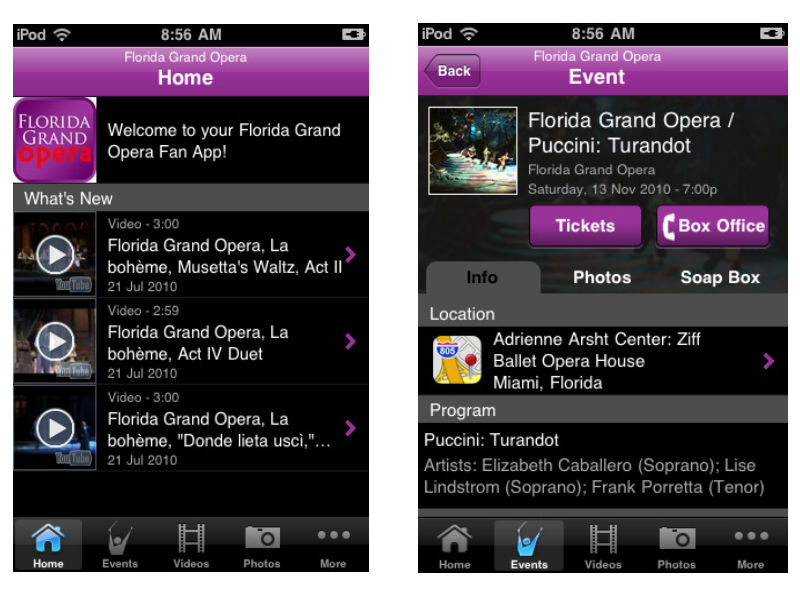 The Breakdown: A great app for the Opera lover in us all, the Florida Grand Opera app offers news about the company, events updates, listings of upcoming performances, and streaming audio of the 2010-2011 season. One aspect of the app I really enjoyed was the videos section, containing a multitude of interviews and performances from the FGO. The only real complaint I have about the app is the necessity to sign up for updates from FGO before being allowed access into the app.
The Breakdown: A great app for the Opera lover in us all, the Florida Grand Opera app offers news about the company, events updates, listings of upcoming performances, and streaming audio of the 2010-2011 season. One aspect of the app I really enjoyed was the videos section, containing a multitude of interviews and performances from the FGO. The only real complaint I have about the app is the necessity to sign up for updates from FGO before being allowed access into the app.
Google Goggles | FREE
Available for: iPhone, Android
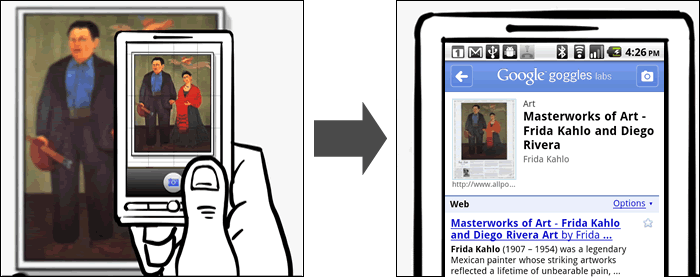
The Breakdown: Google Goggles is a visual search engine built into a mobile app. It utilizes your smartphone's camera to capture and scan an image, object, or landmark and perform a search online to provide information on it. This is a very fun app to play around with and can be very helpful when trying to identify an artwork without a clear label or an unknown landmark. The app is still in beta though and cannot identify anything that is not already currently online in some form.
The L.A. Phil | FREE
Available for: iPhone, Android, & Blackberry
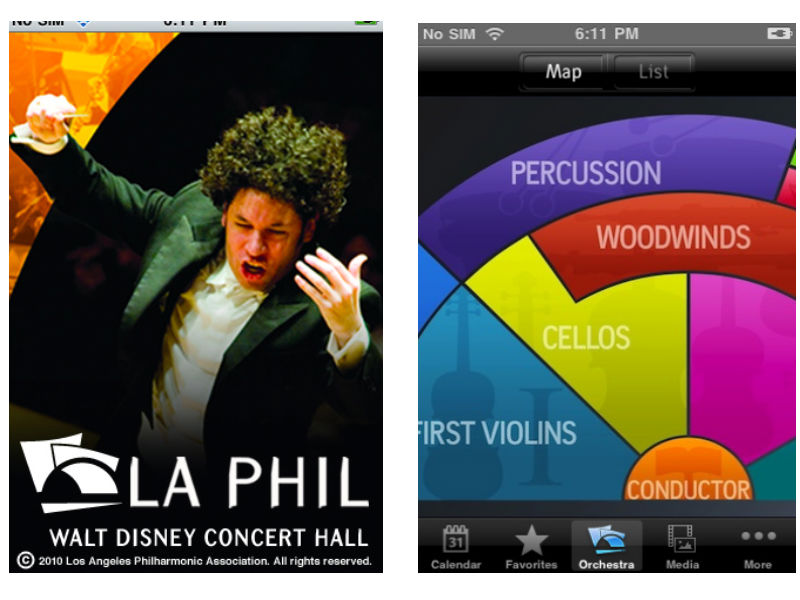 The Breakdown: The LA Philharmonic app has a lot of same offerings as the Florida Grand Opera app in terms of news, media, and listings of events. What sets this app apart is the interactive Orchestra map, laying out the different groups of muscians in the LA Phil. When a user taps on a section of the orchestra, such as First Violins, they are directed to profiles of each musician with in-depth biographies. This app is packed full of great content and an excellent way to learn more about classical music and the people that perform it.
The Breakdown: The LA Philharmonic app has a lot of same offerings as the Florida Grand Opera app in terms of news, media, and listings of events. What sets this app apart is the interactive Orchestra map, laying out the different groups of muscians in the LA Phil. When a user taps on a section of the orchestra, such as First Violins, they are directed to profiles of each musician with in-depth biographies. This app is packed full of great content and an excellent way to learn more about classical music and the people that perform it.
AMNH Explorer | FREE
Available for: iPhone
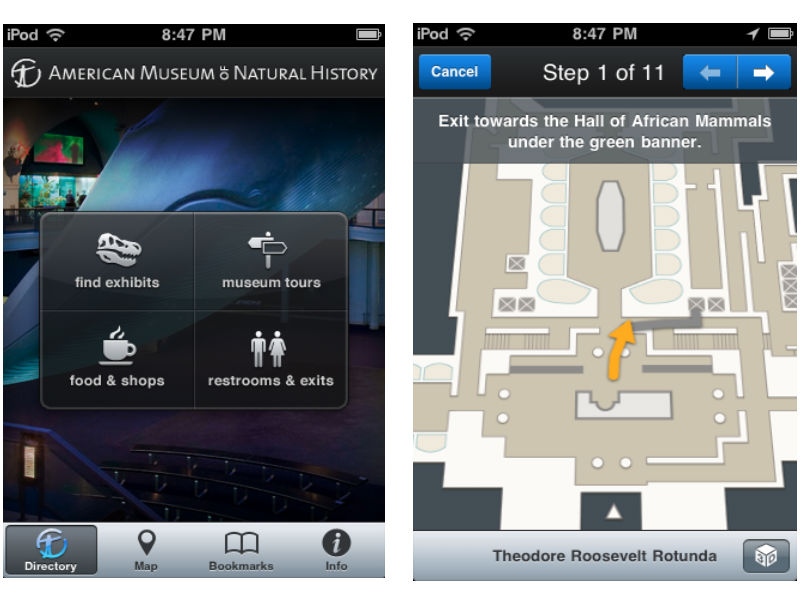 The Breakdown: The Explorer app from the American Museum of Natural History is a great guide for navigating a very large museum. The app acts as a personal in-museum GPS, finding your location and providing information on the exhibits within that area. The app can not only find your location, but provide turn-by-turn directions from one exhibit to the next. This may go against some museum purists love of getting lost within a museum, but on a busy day in a museum packed with visitors this app could be an incredible advantage.
The Breakdown: The Explorer app from the American Museum of Natural History is a great guide for navigating a very large museum. The app acts as a personal in-museum GPS, finding your location and providing information on the exhibits within that area. The app can not only find your location, but provide turn-by-turn directions from one exhibit to the next. This may go against some museum purists love of getting lost within a museum, but on a busy day in a museum packed with visitors this app could be an incredible advantage.
Is This Art? | FREE
Available for: iPhone
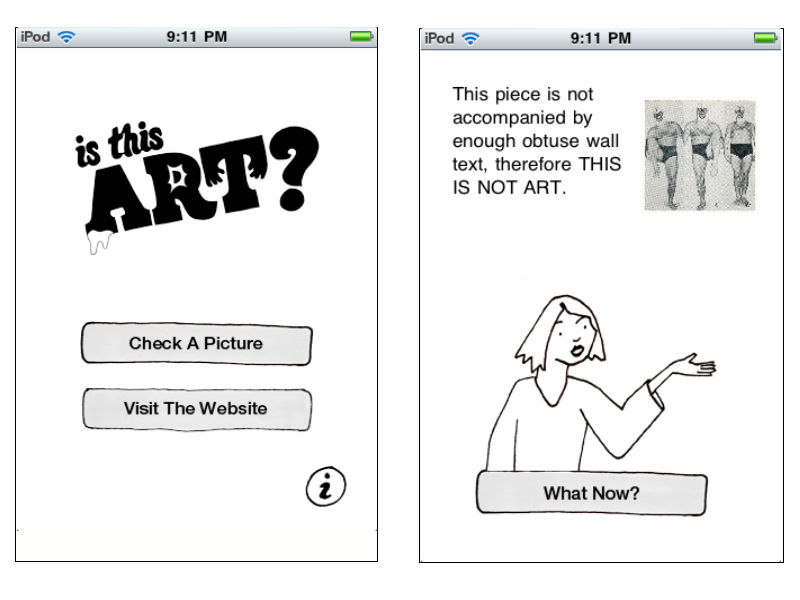 The Breakdown: A fun app from the folks at Deeplocal and the Mattress Factory, Is This Art? is one way to win those age old arguments about what is and isn’t art. Users snap a picture of the art in question and open it within the app to test its validity in the art world. The explanations the app gives are often hilarious such as, "This makes me feel intellectually inferior, therefore THIS IS ART" and, "This piece is not accompanied by enough obtuse wall text, therefore THIS IS NOT ART". All of the images users put to the test can be uploaded to the project's ongoing blog.
The Breakdown: A fun app from the folks at Deeplocal and the Mattress Factory, Is This Art? is one way to win those age old arguments about what is and isn’t art. Users snap a picture of the art in question and open it within the app to test its validity in the art world. The explanations the app gives are often hilarious such as, "This makes me feel intellectually inferior, therefore THIS IS ART" and, "This piece is not accompanied by enough obtuse wall text, therefore THIS IS NOT ART". All of the images users put to the test can be uploaded to the project's ongoing blog.
Brooklyn Museum Mobile | FREE
Available for: iPhone, Android, & Blackberry
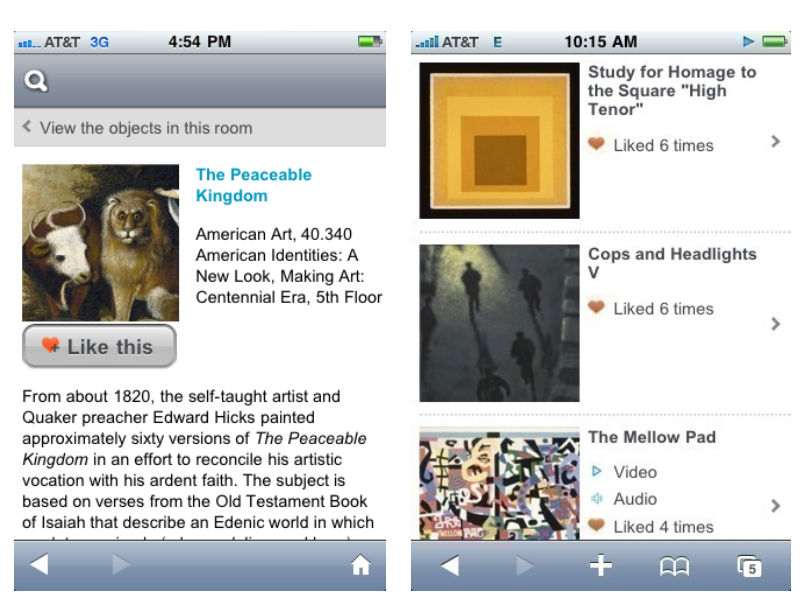
The Breakdown: Another great app for a large museum, Brooklyn Museum Mobile has less of a focus on navigation and more on community and interaction. The app brings in aspects from social media by inviting users to add descriptive tags and/or "like" artworks from the collection. This acts as a recommendation system for other visitors and encourages a more participatory experience. The aspect I like about Brooklyn Museum's offering is that the app runs off of a mobile website, meaning that it is not device exclusive and anyone with a web-enabled device can join in the fun.
The Lighting Handbook | $4.99
Available for: iPhone
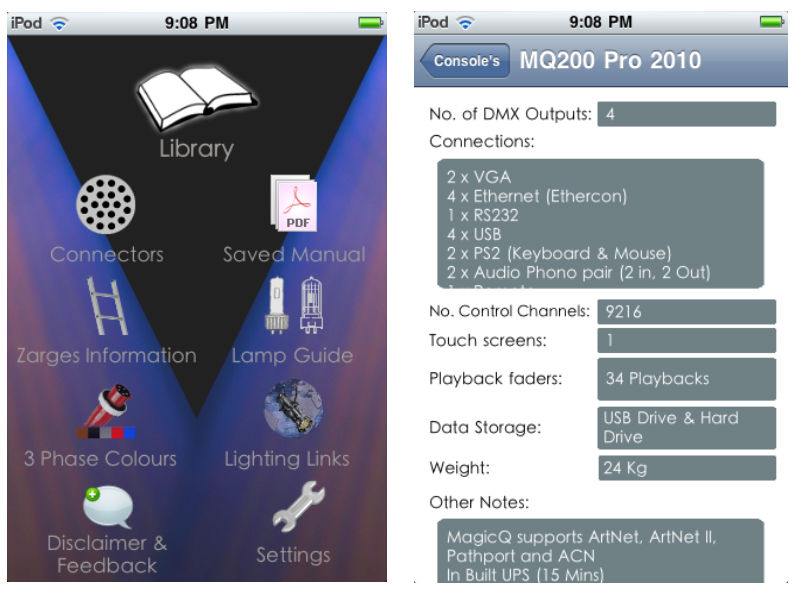 The Breakdown: This is a great app for all of you theater techies. The Lighting Handbook is exactly what it sounds like, an in-depth guide to all things lighting, conveniently in your pocket.
The Breakdown: This is a great app for all of you theater techies. The Lighting Handbook is exactly what it sounds like, an in-depth guide to all things lighting, conveniently in your pocket.
Chicago Gangland Tour | $2.99
Available for: iPhone
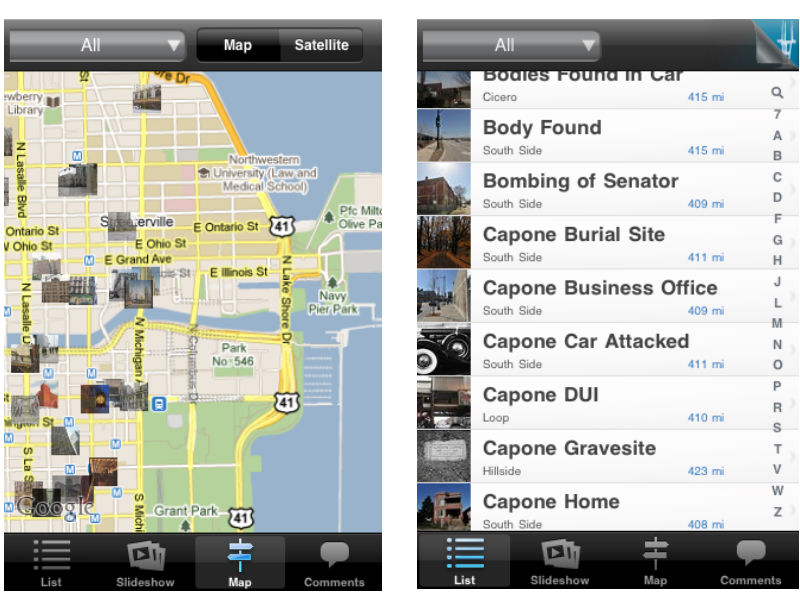
The Breakdown: Ever wanted to walk in the footsteps of famous gangster Al Capone? That's exactly what the Chicago Gangland Tour app helps you do, integrated with google maps to give users a handheld guide for a historical walkthrough of Chicago's mafia history. This app provides info on all the different sites historical relevance and invites users to add their own comments. My favorite aspect of the app is the drop-down menu where results can be sorted by subjects like murders, shootouts, and gangster hideouts.
At The Booth | $0.99
Available for: iPhone, Android
 The Breakdown: At The Booth is a full-service app for attendees of Broadway and Off-Broadway shows in New York City. The main page updates with every launch of the app and includes the latest shows and theater locations. For each show the app provides info on the showtimes, ticket prices, discounts, synopses, links to reviews and videos, and nearby restaurants. Listings will appear with a pink undertone to let users know if there are long lines at the theater. The only real complaint I have about the app is that the listings are only viewable in list form, whereas a map option would really assist in seeing all that is available in the immediate area.
The Breakdown: At The Booth is a full-service app for attendees of Broadway and Off-Broadway shows in New York City. The main page updates with every launch of the app and includes the latest shows and theater locations. For each show the app provides info on the showtimes, ticket prices, discounts, synopses, links to reviews and videos, and nearby restaurants. Listings will appear with a pink undertone to let users know if there are long lines at the theater. The only real complaint I have about the app is that the listings are only viewable in list form, whereas a map option would really assist in seeing all that is available in the immediate area.
The Sundance Festival 2010 | $4.99
Available for: iPhone
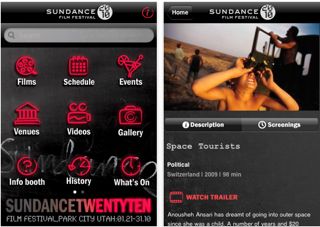
The Breakdown: The Sundance Festival app acts as an online brochure for the annual film festival. In addition to offering videos and reviews on films being shown, the app gives festival attendees real-time updates as to what is happening with the film fest's various events and screenings. The one feature that this app lacks is a way to create custom schedules of screening times and events. This would be invaluable at a festival where multiple things are being offered at once and making the most of the your time requires a lot of planning.
Social Media Spotlight: SF Playhouse Pluggers
Welcome to the fourth installment of the Social Media Spotlight, our monthly feature focusing on arts organizations’ social media strategies.
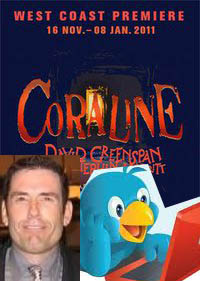 Earlier this year, the SF Playhouse invited Bay Area Twitter users to apply for the SF Playhouse Pluggers, a group of individuals invited to "plug in and Tweet during the performance in special 'tweet seats' where their thoughts will be instantly be shared with the Bay Area and the world." I recently had an opportunity to talk with Dan Meagher, Director of Marketing for SF Playhouse, about this controversial and highly debated social media program.
Earlier this year, the SF Playhouse invited Bay Area Twitter users to apply for the SF Playhouse Pluggers, a group of individuals invited to "plug in and Tweet during the performance in special 'tweet seats' where their thoughts will be instantly be shared with the Bay Area and the world." I recently had an opportunity to talk with Dan Meagher, Director of Marketing for SF Playhouse, about this controversial and highly debated social media program.
What inspired the SF Playhouse to explore a Twitter program?
When I came to the SF Playhouse as Director of Marketing, I wanted to devise a program that would be unique plus tap into social media. Since I had been using Twitter for quite some time and liked the "real-time" aspect of it, I saw the potential for using it in conjunction with a live performance. More importantly, it lets us give folks a voice for their criticism and instant thoughts of our shows. Twitter lives in the moment, just like theatre. We're creating our own critics. There couldn't be a better combination.
How did you arrive at the program name?
The name came about after thinking about what people were doing with this program. They are "plugging" into the show, into social media, and into the SF Playhouse. Plus, it's darn catchy!
How does the program work? How do you find program participants? What are the criteria for participation?
A few weeks before a Plugger event, we start advertising on our Facebook and Twitter pages. The requirements are: - Must be 18 years or older - Must be a Bay Area resident - Must have an active Twitter account - Must have a portable texting device that can last a least 90 minutes.
Participants are selected on a first-applied basis and receive one complimentary ticket to the show, where they sit in the last row. We also extend to them a special ticket offer if they want to bring a friend (who won't be tweeting). We've had Pluggers use everything from cell phones to iPads! We accept 8-101 Pluggers for the event and usually end up with a wait list.
Do they tweet for a single performance or are they invited to come back to tweet throughout the season?
The Pluggers are initially invited for the one performance. Some love it..some find it challenging and not their thing. It's not a program for everyone. We have about a 70% rate of people asking to come back to plug for the next show, but it is important to me to have new people with us each session. We have one guy who has been with us for every Plugger session! It's great to see them arrive and become a group...they get each other's Twitter screen names and even start tweeting to each other during the performance. For that show, they become a community.
Our Pluggers come from all over - different backgrounds, communities, jobs, you name it. We've had them as young as 18 and up to their 60s. Our average age in 30 -40.
What rules (if any) govern the program?
We have a few basic rules: must turn ringers/any sound elements off; all screens must be dimmed; no talking; and no photos or recording devices may be used (we're an Equity theatre). We do let them drink from their seats, which, with a laptop or iPhone, has caused a few spills!
The biggest rule (well, not really a rule) we have is that we will not censor anything our Pluggers have to say. We retweet all of their messages about the show, whether they be good and bad. This has allowed us to gain a trust with our Pluggers and our audience, because they know that they are seeing all of the instant reactions - not just selected ones.
Someone once asked me if this is bad, letting people possibly criticize your production. Actually, I see it as a good thing. Theatre must be able to take the good and the bad. It allows us to see things from another perspective. We've had some Pluggers be very direct about what they didn't like in a show.
Is there a particular hashtag for the Pluggers’ tweets?
#sfplay - We started using this hashtag during our last Pluggers session in the hopes of making the feed more streamlined. Also, in the past, we have crashed our Twitter page because of too many feeds going out at the same time. I have been in touch with the folks at Twitter to ask for their help in maintaining our feed, but they weren't very responsive.
Do you post the hashtag feed on a screen in the lobby for your audience before the show, during intermission, and after the show?
That's a great idea! Unfortunately, we don't have the capability to do that right now. We do mention at the start of the performance to the audience that they should go home and look at our Twitter page and see the live feed.
What are your benchmarks for measuring the success of the program?
I don't use any specific bench marks for the Playhouse Pluggers. Since it's a very "organic" kind of program, I don't feel the need to throw in tickets codes or other marketing positions. We know it works because we have people come to the SF Playhouse and mention that they read the Plugger feed from the last show. We've also received much press coverage.
What feedback has the program received from your on-site audience?
It's funny. When we first announced this program, we received emails from patrons unhappy with the idea. Of course, we heard this before we even did a Pluggers night! However, Executive Director Susi Damilano and Artistic Director Bill English were unwaivering in their support for trying this crazy new idea. Without their support, this would have never gone forward.
After our first session went off without a hitch, we didn't hear many complaints. We have had audience members sitting right behind our Pluggers and, at the end of the show, say they didn't even know the Pluggers were there. The non-Tweeting audience members wouldn't even know it was happening if we didn't tell them. Now that people see that this isn't disruptive to the show, they seem to have embraced it.
What type of response and interaction have the Pluggers’ received from the Twitter community?
The Twitter community has been very supportive of the idea. I've heard from people all over the US and the world about how much they enjoy following the live feed.
Twitter has also brought us some surprises. During our last Pluggers session for the new musical Coraline, who should join in the tweeting but the author himself - Neil Gaiman!
Another wonderful thing happened during our Plugger session for Cormac McCarthy's The Sunset Limited. We were about 40 minutes into the show and suddenly, someone from Twitter-land sent one of our Pluggers a direct message asking them a question about something they just tweeted. That was a first for us. We now had Twitter users from other places asking questions of our Pluggers during the show! It helped me realize the scope this program. Those interactions took the Playhouse Plugger program to a whole new, unexpected level.
Why do you think there has been so much controversy and debate about the program?
Many theatre people are afraid of the "new." Technology scares a lot of folks. We're taught that theatre is a revered place where you come, sit, watch, and applaud. Interaction is not allowed or encouraged. So when you create something that breaks down a wall, people are going to jump up and say, "Not in my backyard!" Here's the bottom line...the Playhouse Pluggers program is not going to end the world or change theatre as we know it. This program will not cause thousands to run out and start tweeting during Romeo & Juliet.
Theatre is about change...about evolution. The basic nature of theatre requires us to adapt to the new, or else we would be going to see plays by Euripides on Broadway. Theatre is a shared experience and this program is just a way to let the theatergoer have voice in the theatre going experience by sharing their thoughts. That's it..it's a very simple concept.
In an article earlier this year, Theatre Bay Area quoted Artistic Director Bill English as saying of the program, “It’s an experiment. We're trying to check out the balance between social media and theatre.” Eight months into the experiment, what has SF Playhouse learned?
We have learned that social media (Twitter, Facebook, YouTube, Skype, etc.) has become a major force in everyday life. It's here to stay. We've also learned that people love to discuss theatre using these platforms. It can connect a theatre fan in England with a theater fan in the US instantly. If anything, social media has opened up lines of instant communication that never existed before and encourage discussion.
I'm happy to share my knowledge about this progam with all! Feel free to contact me at Dan@SFPlayhouse.org
This has lead to the creation of citizen critics. Everyone today has a voice and the ability to broadcast their thoughts. With the demise of print and media criticism, theatre needs to find and cultivate these new voices that will talk, criticize, and promote.
Social Media Spotlight: New York Theatre Network
Welcome to the second installment of the Social Media Spotlight, our monthly feature focusing on arts organizations’ social media strategies.
The global trend of participation in social networks and social media is one to which arts managers have been paying a great deal of attention. With over 500 million active Facebook users, 55 million tweets being sent per day and over 133 million active bloggers in the United States alone, arts organizations and arts managers are growing increasingly interested in identifying ways to engage their audiences and connect to new audiences via social media.
One of the more recent example of the intersection of social media and audience development is the creation of the New York Theatre Network (NYTN). Launched on September 28, NYTN seeks to be “your hub for what’s happening on New York City Stages”. The network focuses specifically on theatre events in New York City, and while any theatre fan can check out the latest happenings, only member theatres are able to upload content about their organization onto the website.
NYTN is unique in that it was designed to be an interactive social network as opposed to a static directory and listing of information. Its Facebook Connect feature enables users to find out what their friends are ‘liking’, ‘attending’ and/or ‘recommending’ and also allows users to make their own recommendations.
Theatres are also encouraged to interact with audiences as they are able to upload YouTube videos, their Twitter stream, blog posts and an event calendar onto their pages. A gracious sponsorship from Flip Video’s Spotlight For Good Program made it possible for member theatres to record video and upload this content onto their page.
NYTN is the result of a cooperative effort between The Alliance of Resident Theatres/ New York and theatre industry website Theater Mania. A.R.T. New York Executive Director Virginia Louloudes was inspired by a keynote speech delivered by Diane Ragsdale of the Andrew Mellon Foundation two years ago in which she addressed the decline in arts participation and examined possible solutions for this dilemma. One suggestion was for arts organizations to consider becoming “arts concierges” and help consumers find shows and performances based on their individual tastes.
Louloudes saw an opportunity to create a site that would serve as a “one stop shop” for theatre fans, encourage a new level of interaction between theatres and audiences, and introduce fans to new theatres and upcoming shows they may not have been aware of. The project was an extensive one and called for outside funding, workshops with member theatres, and a partnership with Theater Mania for technological support. While such an ambitious project may not be feasible for all arts organizations, Louloudes hopes that the creation of NYTN will encourage arts managers to develop their own social media strategies, especially since most platforms are free.
Those interested in further reading on NYTN's marketing efforts should also consult the following blog articles from Devon Smith, who served as project manager for NYTN and frequently blogs about social media:









